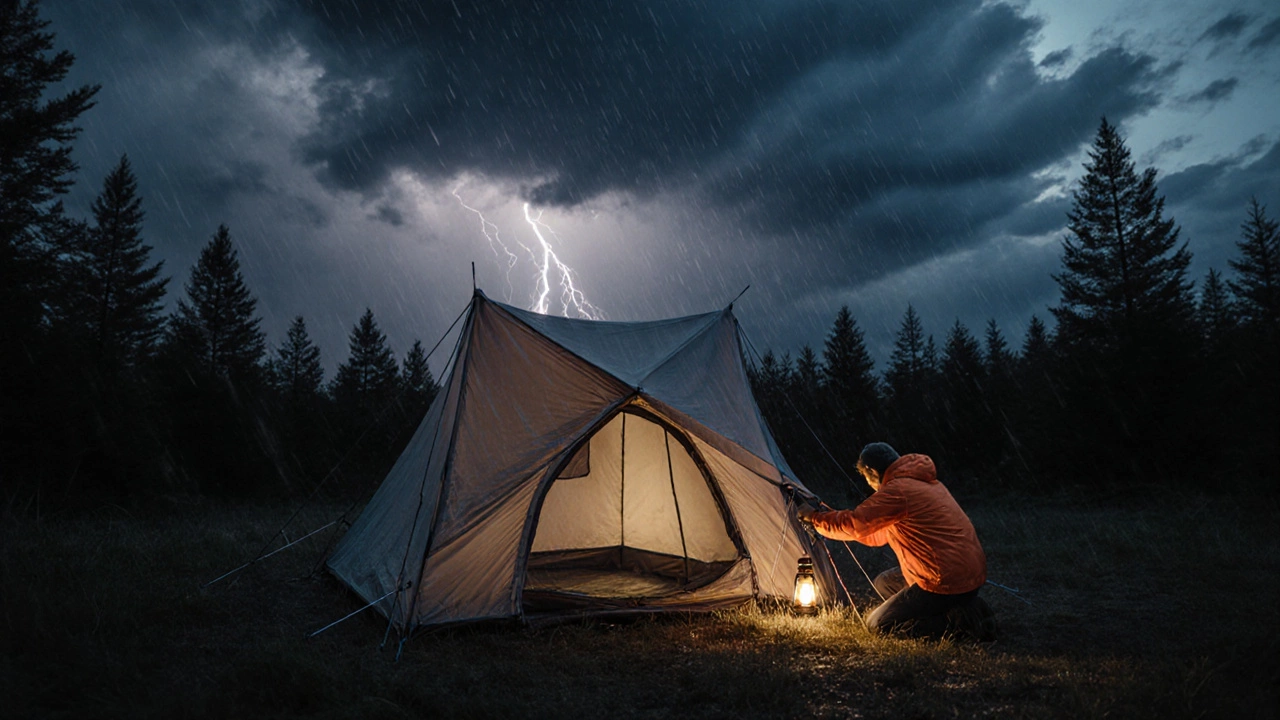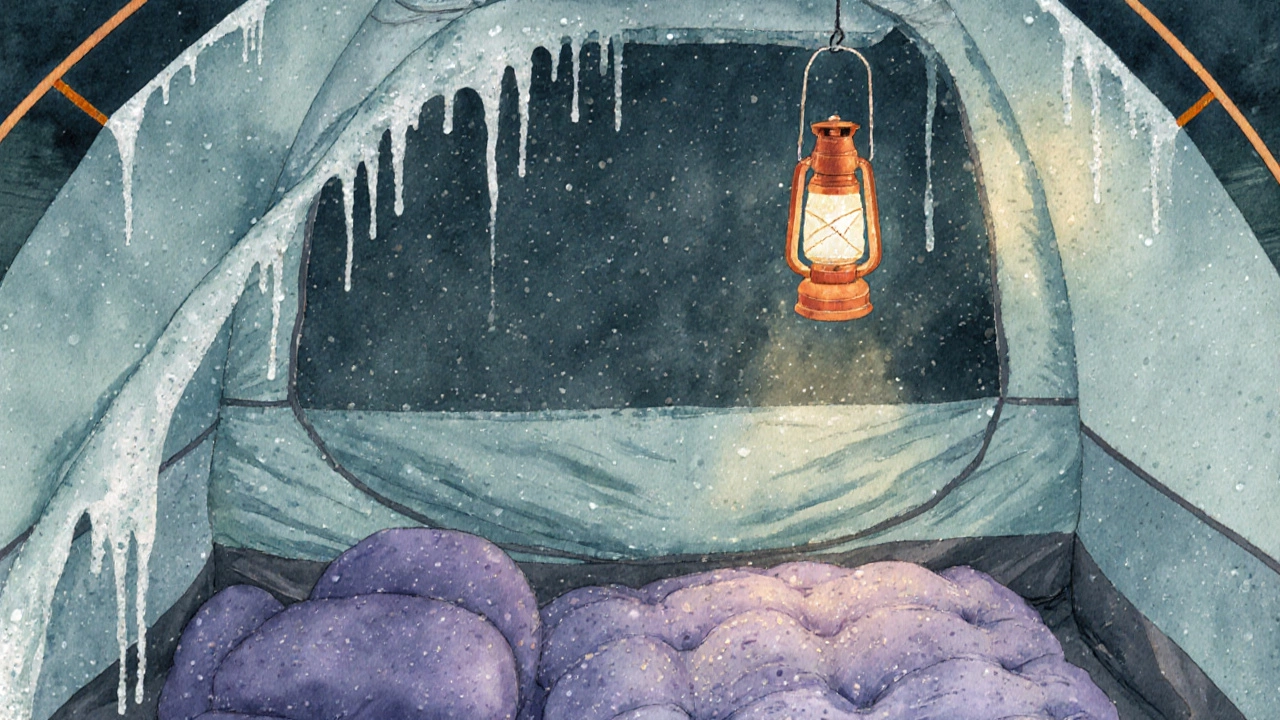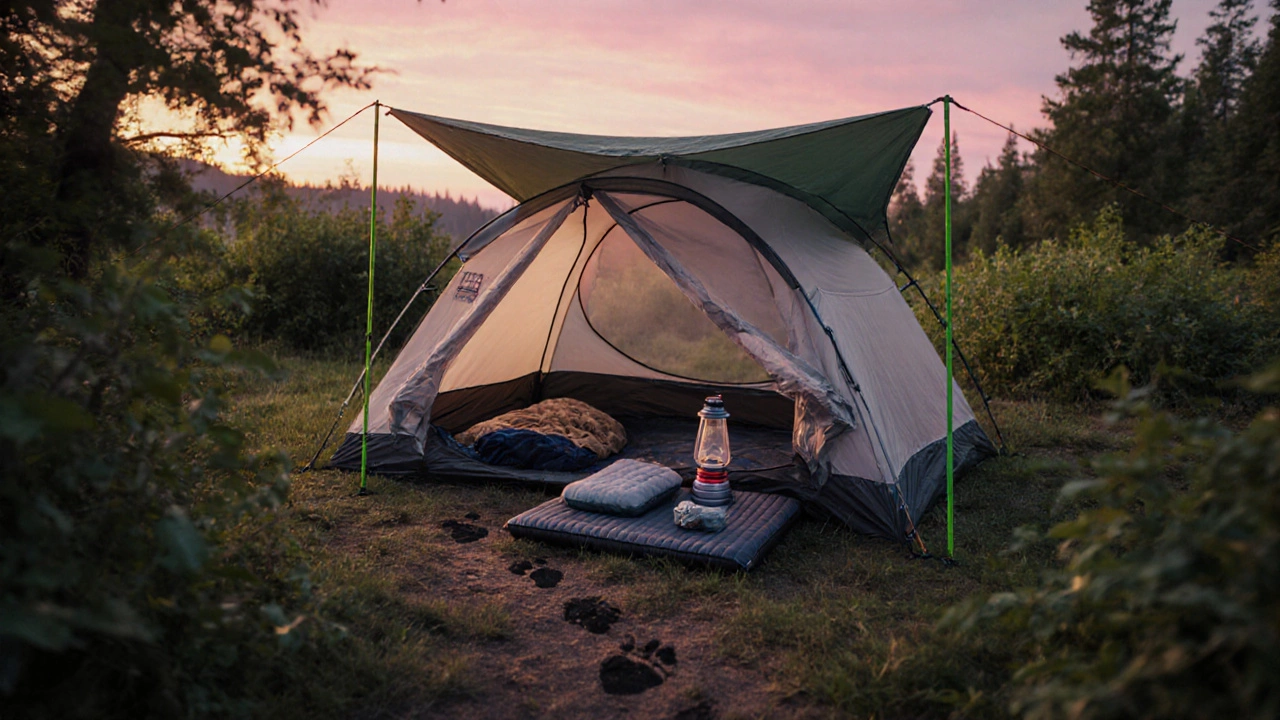Tent Disadvantages: 7 Drawbacks of Sleeping in a Tent
 Oct, 13 2025
Oct, 13 2025
Tent Weather & Setup Calculator
Weather Assessment
Risk LevelWeather Suitability
Setup Time Estimate
Recommended Actions
Key Takeaways
- Weather exposure can turn a comfortable night into a miserable one.
- Condensation and ground moisture often make the inside of a tent damp.
- Insects and wildlife pose safety and comfort challenges.
- Setup and takedown take time and can be physically demanding.
- Limited privacy and space affect family or group camps.
- Environmental impact rises when tents are placed improperly.
- Many issues are solvable with proper gear and planning.
When you picture a night under the stars, the image of a simple canvas shelter often feels romantic. But before you pack that Tent is a portable, fabric shelter that provides minimal protection from the elements while you sleep outdoors. It’s worth knowing the downsides so you can decide if a tent fits your adventure style or if another option would serve you better.
1. Weather Exposure: The Double‑Edged Sword
Even the best‑rated rainfly can’t guarantee a dry interior during a downpour. Weather includes rain, wind, snow, and temperature extremes. When a storm hits, wind can rip the canvas, and rain may seep through seams or the floor, leaving you soaked and cold. In colder climates the loss of body heat can lead to hypothermia within minutes.
Many campers underestimate how quickly a night can shift from pleasant to perilous. A simple rule of thumb: if the forecast calls for more than 0.2 inches of rain, plan for a backup shelter or bring a tarp with additional guy lines.
2. Condensation: The Hidden Moisture Monster
Inside a sealed tent, Condensation is water vapor that forms on the inner walls when warm breath meets cooler air. On humid evenings, the interior can become damp, soaking sleeping pads and sleeping bags. This not only reduces comfort but also raises the risk of mold on gear.
Ventilation flaps, mesh panels, and opening the rainfly for short periods can mitigate the problem, but the trade‑off is reduced protection from rain and wind.
3. Ground Moisture and Cold
The soil beneath a campsite rarely stays dry, especially after rain or in low‑lying areas. Ground moisture conducts heat away from your body far more efficiently than air, leaving you chilling through the night. Without an insulated groundsheet, the cold can seep directly into the sleeping bag.
Using a closed‑cell foam pad or an insulated sleeping pad adds a layer of protection, but it also adds weight and bulk to your pack.

4. Insects, Wildlife, and Safety Concerns
Open mesh windows keep ventilation high but also invite insects such as mosquitoes, flies, and beetles. These pests can turn a peaceful night into an itchy nightmare. In regions with ticks or sandflies, the health risk increases.
Beyond insects, larger wildlife-racoons, possums, even bears in some regions-may be curious about food odors. Improper food storage can lead to animals breaking into the tent, posing both a danger to you and the animal.
Solutions include using a bug net, applying insect repellent, and following proper food‑storage protocols like bear‑proof containers.
5. Setup and Takedown: Time‑Consuming and Physically Demanding
Modern tents range from a single‑pole pop‑up to complex four‑pole designs with multiple vestibules. Even a quick‑pitch model can take 10‑15 minutes to stake, especially on uneven ground. In windy conditions, the process becomes even slower and frustrating.
For solo hikers, the physical effort of spreading the footprint, hammering stakes, and tensioning guy lines can be exhausting after a day on the trail. This fatigue can affect your morale and overall experience.
6. Limited Space, Privacy, and Comfort
A standard two‑person tent offers about 30 square feet of floor space. That may feel cramped for families, couples, or gear‑heavy backpackers. The lack of separate compartments means you can’t store clothes away from sleeping areas, leading to a cluttered interior.
Privacy is another issue. In shared campsites, you may be within sight of neighboring tents, which can be uncomfortable for some campers, especially when changing clothes or using the bathroom.
7. Environmental Impact: Leaving No Trace Isn’t Easy
Improper campsite selection can damage delicate vegetation. Setting up a tent on sensitive alpine meadows or wetlands can crush plant roots and increase erosion. In high‑traffic areas, repeated tent placements create visible “tented” scars on the landscape.
Following the Leave No Trace principles-choosing durable surfaces, using a footprint, and packing out all waste-helps minimize this impact, but it requires discipline and forethought.

Mitigation Strategies: Turning Disadvantages into Manageable Issues
Knowing the downsides is only half the battle. Below are practical steps that can reduce most of the drawbacks listed above.
- Weather‑proofing: Invest in a high‑quality rainfly with waterproof seams and a bathtub‑style floor. Add a tarp for extra runoff.
- Condensation control: Open vents whenever possible, use a breathable liner, and avoid cooking inside the tent.
- Ground insulation: Use an insulated sleeping pad and a groundsheet taped securely to the floor.
- Insect defense: Choose a tent with small‑mesh netting, apply permethrin to clothing, and keep food sealed.
- Setup efficiency: Practice pitching at home, organize stakes and guylines in separate pockets, and choose a tent with color‑coded poles.
- Space management: Opt for a tent with vestibules for gear storage, and consider a larger footprint for families.
- Eco‑friendly camping: Use a lightweight footprint, stay on established campsites, and pack out everything you bring in.
Comparison Table: Tent vs. Common Alternatives
| Aspect | Tent | Cabin/ Lodge | Glamping Yurt | RV/ Motorhome |
|---|---|---|---|---|
| Weather protection | Variable - depends on rainfly quality | Solid walls, heating, air‑conditioning | Insulated canvas, often heating | Fully climate‑controlled |
| Setup / takedown time | 10‑30min (weather dependent) | None - permanent structure | Minimal - pre‑erected frame | None - vehicle is the shelter |
| Cost (per night) | Low - equipment cost amortized | Medium - cabin fees | High - premium glamping rates | High - rental or ownership costs |
| Privacy | Limited - flat walls, close proximity to neighbors | Good - separate rooms | Good - often separate sleeping area | Excellent - interior doors |
| Environmental impact | Low if practiced responsibly | Medium - permanent footprint | Medium - larger footprint | High - fuel consumption, road wear |
When a Tent Might Still Be the Best Choice
If you value mobility, low cost, and the authentic feel of sleeping under the stars, a tent remains unmatched. For solo hikers, ultralight backpackers, or anyone who enjoys “leave no trace” adventures, the disadvantages are manageable with proper preparation.
Ultimately, the decision hinges on your priorities: comfort vs. freedom, budget vs. luxury, minimal impact vs. convenience. Knowing the pitfalls lets you weigh them against the benefits.
Frequently Asked Questions
Can I prevent condensation inside my tent?
Yes. Use a tent with breathable fabrics, keep ventilation flaps open whenever the weather allows, and avoid cooking inside. A small heat source like a candle (in a safe holder) can also help dry the interior.
What’s the best way to protect against insects?
Choose a tent with fine mesh screens, treat your clothing with permethrin, set up a bug‑net canopy if needed, and keep food sealed. Using citronella candles around the vestibule can also deter flying insects.
Is a groundsheet necessary?
A groundsheet adds a waterproof barrier that protects the tent floor from punctures and moisture. It also extends the life of your tent by shielding the floor from abrasive ground surfaces.
How do I choose a tent that works in both summer and winter?
Look for a four‑season design with a sturdy pole structure, a full‑coverage rainfly, and a bathtub floor. These tents handle snow load and strong winds while still providing ventilation for warm nights.
What are the most common mistakes first‑time tent campers make?
Skipping a proper site survey, neglecting to stake the tent securely, forgetting a footprint, and packing too many gadgets inside the limited space. Each of these can turn a great night into a stressful one.
If you keep these points in mind, the tent disadvantages become manageable hurdles rather than deal‑breakers. Happy camping!